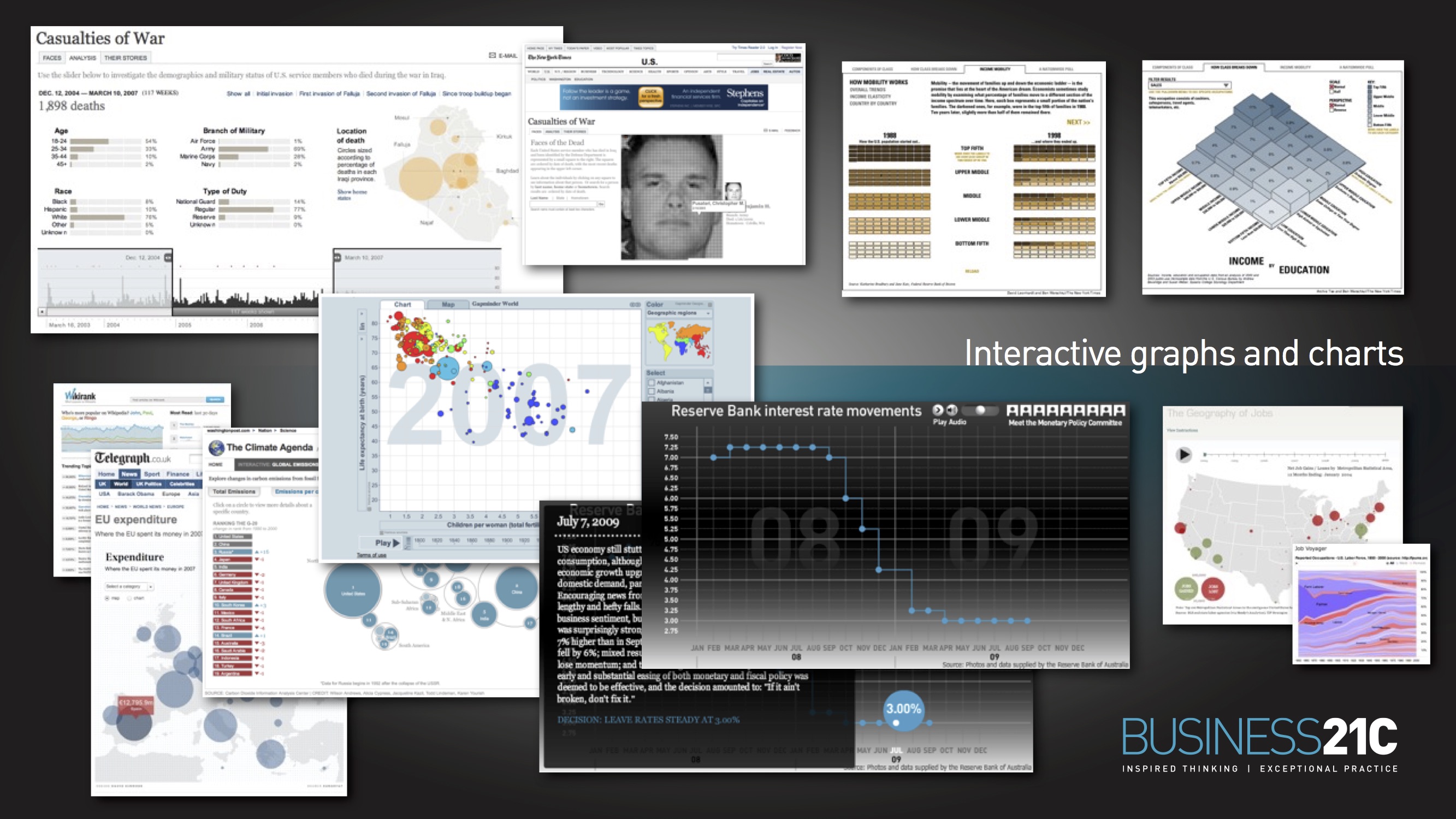Companies, universities and governments spend billions on gathering data and knowledge, but they have failed to keep up with the times when it comes to finding ways to communicate the information. There is vast potential for adding value to the world of information management and dissemination by focusing on the front end. This article was first published by the University of Technology Sydney’s publication Business21C.
The volume and quality of business information has multiplied out of sight since the advent of the internet. But the number of hours in the day has not. Companies, governments, and universities have used internet technologies to develop myriad ways of collecting, interpreting and analysing data, generating an infinite pool of solid, reliable information. But in large part they have neglected to explore new and innovative ways of getting that information into people’s heads. In a world of exponentially multiplying information, new ways of telling stories offer far greater opportunities for disseminating knowledge than simply generating more data.
Fulfilling the knowledge charter
UTS is at the heart of the information producing industry. Original research is the foundation of the university’s charter, reputation and claim on funding. But generating high quality, credible research is just half the job. It then needs to be turned into knowledge.
We all know that academic discourse is impenetrable. Original research is only supposed to be read and understood by a small minority. But underneath the jargon-riddled journal papers lies a treasure trove of knowledge that fulfills the second part of our mission: educating and informing people so that they can live better, more productive, more worthwhile lives.
That is what teaching is all about. But what about the millions of people who could benefit from that knowledge, but aren’t in the classroom at the right time?
That’s where internet technologies come in.
Apart from putting papers and presentations online, the occasional video lecture, and more recently podcasting, little has been done to translate the knowledge that we have into truly absorbing, easily communicated, well-appreciated and easily disseminated knowledge.
UTS: Business’ new website, business21c.com.au is about exploring the opportunities that open up when we add design and technology expertise to our pool of knowledge. By spending time and thought on the communication of the myriad insights that the business faculty generates each year, we can multiply its value many times over.
On the cusp of the design revolution
We’ve just lived through the information revolution. We are now on the cusp of the design revolution.
If you doubt that design can be a revolutionary force, think of Harry Beck. Beck was an employee of London Underground tasked with redesigning the map of the subway system. He realized that because the subway was, well, underground, clearly modeling the interconnections of The Tube network was more important for its users than a strict relationship with geographical space above ground. The result is a brilliantly usable map, with simplified and distorted geography, and shows how well humans work with mental models as tools for understanding.
Or think of the more recent success of Apple. The iPod has already become a hackneyed example of how design can change everything because design and user experience is at the heart of Apple’s value proposition.
Business21C.com.au: leading the business information design revolution
We have already started experimenting with new ways of designing information on business21c.com.au.
Apart from an extensive library of articles, podcasts and video interviews with UTS business faculty – of the kind you would expect from any good business school site – we have developed a new and unique format for the presentation of business stories.
Our feature article on the home page of business21c.com.au at launch is a three- dimensional universal feature called The Business Information Design Revolution: Investing in Australia’s knowledge future. Its content mirrors that of Roy Green’s UTSpeaks presentation, delivered in July this year, but its format applies the principles of design thinking to the knowledge contained in the presentation itself.
This format allows users to drive their own knowledge experience. You might have an hour to explore all the ideas contained in the presentation and the links between them. Or you may have only enough time to pick up the bare bones of the story being told. Either way, the feature is designed to apply design principles to the way we tell our stories, and in doing so, maximise the user’s knowledge-to-time ratio.
The 3-D universe is just one of an infinite number of ways of applying design thinking to business information. We invite you to explore it and imagine how your stories might be told using this kind of approach and technology. We’d love to tell them.
It is early days, but we believe there are four promising avenues for exploring the potential for business information design:
1. Design thinking
In many cases it is simply a matter of imagining what might be possible. If you could tell your story any way, how would you do it? What are the main nodes of information and how do they link together? What are the logical connections between the parts of the story, and how would you represent them if you weren’t limited to a two-dimensional beginning, middle and end? Because you’re not.
2. Usability
The success of Apple is almost entirely down to Steve Jobs’ legendary, fundamentalist focus on usability. Usability is key to effective information design. Luckily there is tonnes of inspiration out there: from Edward Tufte’s criticism of ‘PowerPoint thinking’ through to more esoteric theory such as the philosophy of language in logical positivism that led to the creation of the now ubiquitous Pictograms that power the world’s signage systems and social diagrams.
3. Live data
The latest weather forecasts, movements of currency exchange rates, and Google maps, amongst many others, are examples of readily usable live data. The next incarnation of the internet – web 3.0 or the semantic web – will enable an entirely new form of information representation, in real time with real data feeds.
4. A diagramming engine
Bespoke diagrams provide unique and particular ways of viewing data, but they also require man-hours across several disciplines, and they have limitations when dealing with live, changeable, data. So we’re looking for principles of interaction, usability and data representation, which may be formalised into a hosted, diagramming web service.

Scott David leads User Experience strategy and design at the World Economic Forum, across their digital platforms for data-driven knowledge and communities of global leadership.













